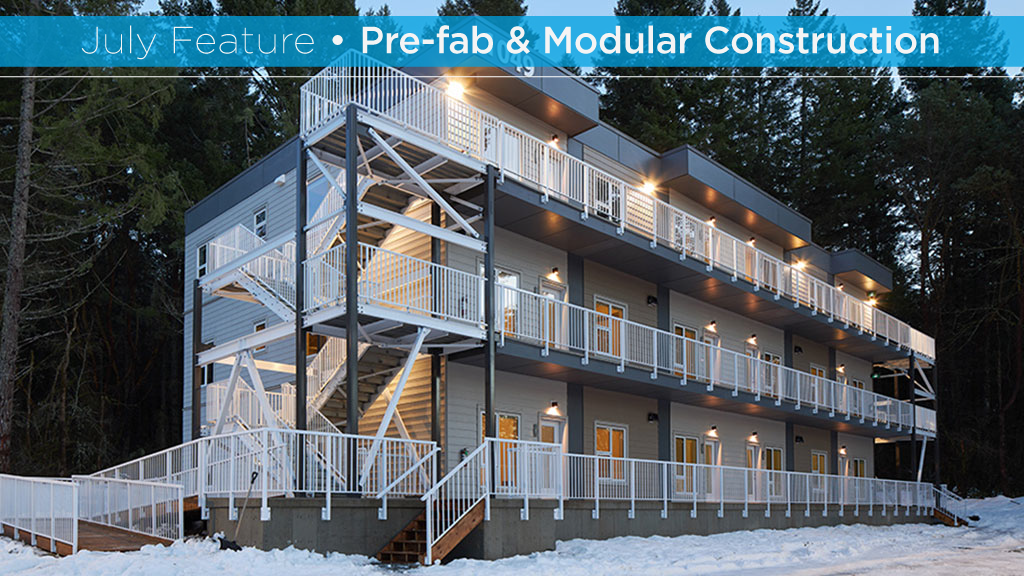It’s time to cast aside any prejudices about pre-fabricated residential developments.
No longer are they simple square boxes more suitable for a remote construction site than as permanent homes. And never has there been a better time to consider pre-fabrication to meet the crushing demand for housing across Canada.
According to a 2023 Desjardins report, “Housing starts would have to increase immediately by almost 50 per cent nationally relative to our baseline scenario and stay there through 2024 to offset the price gains from the increase in federal immigration. This is equivalent to about 100,000 more housing starts on average annually in 2023 and 2024 relative to our baseline, and would lead to the highest level of housing starts in Canadian history.”
Paul De Berardis, director of building science and innovation for the Residential Construction Council of Ontario, recently stated to his membership that homebuilding has “become more complex to construct through increasing regulatory requirements and takes more time and resources to build.”
Perhaps it’s a signal for the residential housing industry to evolve.
As former Vancouver Mayor Gregor Robertson recently told the Globe & Mail, “Homes and buildings are the last and only product we build from scratch onsite — everything else is manufactured,” he said. “(Construction) is the last industry to embrace much higher efficiency, and getting away from custom, bespoke design for each unit.”
Multi-unit housing is needed as badly as single-family homes. Volumetric modularization could be an answer for both.
Nowadays, volumetric modular homes are shedding deep-seated stereotypes from the past. By design, they are limited only by imagination. In execution, they can exceed all provincial building codes and standards.
More importantly, volumetric processes address key issues facing today’s housing industry. Less skilled labour is required to manufacture units in factories and to assemble them onsite. Supply chain issues can be managed more effectively. Quality control is higher in a factory setting.
Fewer workers spending less time onsite cutting, hammering and climbing reduces also risks of injury. Instead, sections and volumetric units can be craned into position with minimal labour and material.
Pre-fabricated housing can be erected and closed in quickly, an important advantage given Canada’s changeable weather.
When it comes to multi-unit residential development, the efficiencies resulting from completing and occupying a project on schedule and on budget ultimately improves the bottom line, even if the project’s material construction cost is equal to a conventional build.
On average there is an 80 per cent reduction in site deliveries, and evidence of onsite time savings of as much as 50 per cent, according to information supplied by the U.K.’s Tide Construction, a developer and experienced builder of large multi-unit pre-fabricated residences.
For an industry that has long lagged other sectors in reducing carbon emissions, builders committed to putting their best environmental foot forward through sound construction practices should be attracted to modular, particularly when codes and regulations evolve and public expectations increase.
Pre-fabricated construction requires 67 per cent less energy than traditional building methods, says global real estate service company CBRE, and is far more efficient in its use of building materials.
Since materials are cut to shape by digital technology, material waste is reduced. Tide reports 99 per cent of their factory waste is either recycled or used for energy recovery.
This in turn reduces waste onsite significantly. Further carbon footprints are reduced due to less transportation of materials to the site, up to 40 per cent according to a study by U.K.-based KLH Sustainability.
Volumetric modular multi-unit projects are proving highly successful around Canada and the United States.
In North Saanich on Vancouver Island, Nomodic Modular Structures of Calgary completed a 12,000-square-foot, three-level housing complex in January 2022 for the Pauquachin First Nation in 181 days. Elsewhere, a 48-suite supportive housing complex for BC Housing in Duncan will soon open, after the last of the 60 modules were successfully craned into place in March.
RCM Modular Solutions based in Saint-Benoît-Labre, Que., has demonstrated that volumetric housing needn’t be restricted to assisted housing projects.
Over 36 weeks of total production and assembly time, the company completed a 136-unit upscale multiunit residential complex in Poughkeepsie, N.Y.
A recent report from the Modular Building Institute (MBI) states the multifamily sector accounts for one-third of all factory-built output in North America. Nevertheless, the MBI estimates modular construction only accounted for only 6.14 per cent of the total square footage of new construction in 2022.
Clearly, there is plenty of room for the pre-fabrication industry to grow.



Recent Comments